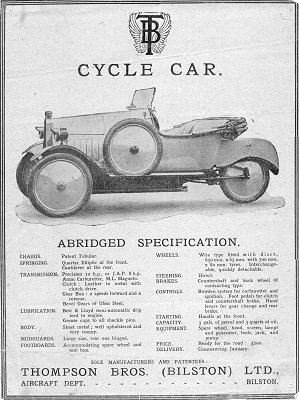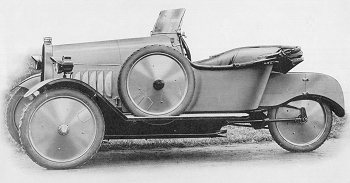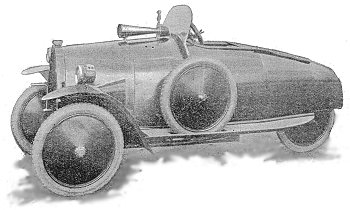| Thompson Brothers (Bilston) Ltd. was founded in 1882.
The company manufactured boilers, galvanised baths, iron or steel
pans and tanks, and items for use in collieries.
The factory in Great Bridge Road, Bilston was originally called
Bradley Boiler Works, but during the First World War it became
Bradley Engineering Works.
An
aviation department was established during the First World War, to produce much
needed aircraft components.
The factory was extended
so that Thompson Brothers could fulfil its military contracts.
The new buildings consisted of three interconnected wooden
buildings with Belfast roofs. These housed sheet metal shops, a wood
mill and machine shops.
An advert from 1896. |
 |
|

A 1919 advertisement. Courtesy of Peter
Slater. |
When the war ended, so did the Government contracts
and the company was in deep trouble. At the time there was a cycle
car boom and so Thompson Brothers decided to manufacture a three wheeled,
open, two seater, cycle car.
The design was entirely original in concept and combined the
practise of aircraft engineering with motor engineering, using high
standards of workmanship and carefully selected materials. |
| Development work was carried out over a period of 12
months and a prototype model completed a 2,000 mile test, during
which no adjustments or alterations were necessary.
One of the main
features of the design was the engine, clutch and 3 speed gearbox,
which were housed in a centrally mounted unit. It was coupled to the
rear wheel drive by two universal joints. The drive operated the
rear wheel through a set of bevel gears. |

A plan view of the chassis. Courtesy of
Peter Slater.
|
|

A side view of the chassis. Courtesy of
Peter Slater.
|
The patent tubular chassis was very strong and had a
special rear portion which eliminated the 'roll', 'sway' and rear
wheel canting that were often problems with this type of car.
At the
front was a dummy radiator that formed part of the petrol tank,
which extended over the top of the air-cooled engine. It held 3
gallons of petrol and 3 quarts of oil. |
| The car was fitted with a 10h.p., or 8h.p. J.A.P.
engine, Amac carburettor, M.L. magneto and a leather to metal
clutch. The initial selling price was £200, which included a spare
wheel, hood, screen, horn, lamps, tools, jack and air pump. The
first models were put on display in November 1919 and deliveries
commenced from early 1920. |

The 8h.p. J.A.P. engine. Courtesy of Peter
Slater.
|
|

From a 1919 sales leaflet. Courtesy of
Peter Slater. |
Ample leg room was provided in the two seater metal
body. The seats were particularly low and well sprung, which
combined with the efficient springing, provided the utmost comfort
for both driver and passenger. A spare wheel was provided and
carried on the near-side running board. An acetylene generator and
tool locker was carried on the offside running board. |

The specification from the 1919 sales leaflet.
Courtesy of Peter Slater.
|

The sporting model T.B. monocar. |
The single seater sporting model appeared in 1920.
It used the same tubular frame chassis as the two seater and was
fitted with a different body. The car was powered by an 8h.p. air
cooled 'V' engine with a 2 speed and reverse gearbox. There
was a shaft drive and centrally fitted steering column. The car was
described as having ample room for the driver and luggage. It was
also fitted with an emergency seat at the rear for an occasional
passenger. |
|
The body was well upholstered and finished in scarlet
and black. The disc wheels added to its sporting appearance. The
company began to take part in competitions and had some success. In
1921 T.B. won the gold medal in the London to Land's End race and
one gold and one silver medal in the London-Exeter and Victory Cup
Trials. The standard two seater had a top speed of 50m.p.h. and all
three wheels were interchangeable. The fuel consumption was 50m.p.g.
to 60m.p.g.
|

An advert from1921.
|
|

The oiling points. Courtesy of Peter
Slater. |
In 1921 an 8 to 10 h.p. water-cooled version was
launched using a conventional radiator. It had a 3 speed and reverse
gear box, an Amac or B. & B. carburettor, Lucas magneto, and a sheet
steel body. Wire wheels were now standard on all models.
The rear wheel could easily be removed in about four minutes
and was interchangeable with the front wheels. It was sprung by
two long cantilever springs which swung on a large diameter
tube. This arrangement together with the patented sub-frame gave
excellent road holding, the car was as steady on corners as most
four wheelers. The air-cooled version sold for £235 and the
water-cooled version was priced at £250. The tax, which was the
same as for a motorcycle, was only £4. By late 1922 these
prices had fallen to £155 and £165.10s respectively. |
| The steering was of the direct type and was no
harder to steer than a conventional motorcycle combination. The
steering column was stationary with the steering tube inside. It was
mounted on bushes and its quick action gave the driver perfect
control of the vehicle. The steering column was directly linked to
the steering rod and fork ends by a connecting rod and universal
joint. Unlike its modern counterparts it did require frequent
lubrication. |

The steering gear. Courtesy of Peter
Slater. |
|

Thompson Brothers works. Courtesy of Peter
Slater. |
The works were situated on the edge of a piece of
disused land which was composed of small hillocks with a few
rough and rutty paths. This area became the testing ground for
the cars and enabled the designers to examine them working under
extreme conditions. There was even a hill with a one in three
gradient, up which the cars managed to climb. |
| The testing and the
subsequent modifications led to a very reliable and high
performance vehicle which could run smoothly in the harshest of
conditions. The cars were run in various competitions and
trials, which were popular at the time. Partly because of the
vigorous testing carried out on the disused land, they were
extremely successful and won 36 gold medals during a period of
two and a half years.
| View a list of
the T.B. competition results |
 |
|
|

A T.B. Sports Model. Courtesy of Peter
Slater. |
|

|
The 1922 instrument board.
Photograph courtesy of Peter Slater. |
| The adjustable steering
column.
Drawing courtesy of Peter Slater. |
 |
|

The dynamo. Courtesy of Peter Slater.
|
The Lucas dynamo was carried on top of the
flywheel casing and chain driven from the external flywheel. |
| The starting handle engaged with a sprocket,
carried on the shaft, fitted to the timing cover of the J.A.P.
engine. It was geared up with a ratio of two to one. When pushed
inwards it engaged with the sprocket and rotated the engine. |

The starting handle. Courtesy of Peter
Slater.
|
|

|
Spares etc. were
accommodated in the locker that was immediately behind the
driving seat.
Photograph courtesy of Peter Slater. |
|
In 1923 production doubled and a good future seemed certain. Four models
were produced in 1924. The water-cooled 'De Luxe Model' sold for £160,
the water-cooled 'Family Model' sold for £162, the water-cooled 'Sports
Model sold for £170, and the air-cooled 'Standard Model' sold for £152.
By 1924 Thompson Brothers had only produced about 150 T.B's. because of
difficulties in obtaining parts from suppliers. |

A 'Sports Model' in operation. Courtesy of
Peter Slater.
|
Cycle cars were initially popular because they were far
cheaper than 4 wheeled cars and cost little to run. By the mid 1920s all
this had changed because the cost of 4 wheeled cars had fallen to such
an extent that they were only slightly more expensive than cycle cars. A
good example of this can be seen from the prices of the locally produced
Clynos. In 1923 a Clyno 4 seater 'Family Model' was priced at £238. By
1925 the Clyno 'Royal' 4 seater was £215 and the 'Royal' 2 seater was
priced at just £210.
Production of the T.B. ended in 1924. A
prototype 4 wheel car was also produced but never entered production.
Because of the production difficulties, the company decided to
concentrate on commercial vehicles and eventually became one of the
world's leading road tanker manufacturers. The company also became known
for its airport fire tenders and became part of the Northern Engineering
Industries Group.
I would like to thank Peter Slater for his help in
producing this section.
 |
|

|
|
View some of the T.B.
cars |
|
Return to the list
of manufacturers |
|



